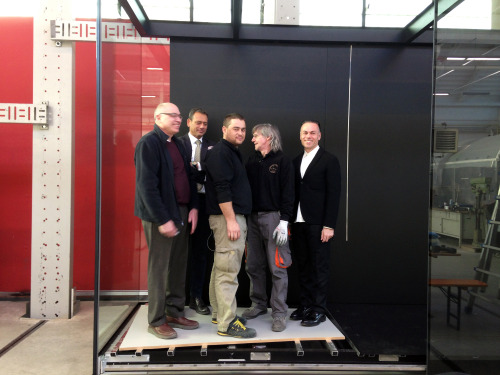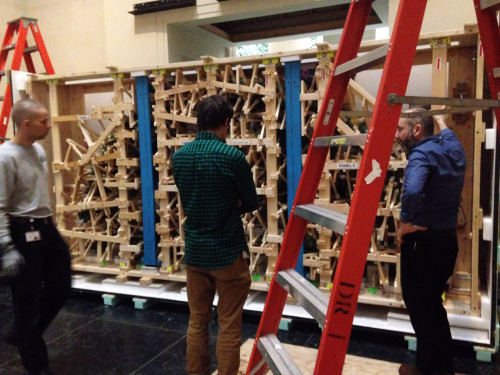Conservators are interested in what surrounds art objects. So, what surrounds them? Cases and crates
Conservators are interested in what surrounds art objects. So, what surrounds them? Cases and crates, of course! Both have a significant impact on the preservation of art objects.As previous posts have discussed, conservators test case materials to ensure that there is no off-gassing of vapors that can cause corrosion or other harm to collections. But materials aside, we also have to ensure that the cases are structural, easily operable for the art handling team and able to support the weight of what is being put inside the case. Pictured above is the Museum’s Chief Designer Matthew Yokobosky (far right) with designers and engineers from the Italian case design firm—Goppion. They are standing inside a huge case being constructed for our Asian Galleries (currently under renovation) to test the weight load and to simulate how the case will function during installation. Art handlers will have to actually climb inside these oversized cases when installing the art, so we need to ensure that the cases can support both the art handlers and the art. The cases must also be designed so that the huge glass sides, nearly 17 feet long, can easily and safely be moved. All of this takes a great deal of specialized engineering.Speaking of which, traveling crate design also involves a lot of engineering! Just as with the handling of artworks during an installation, the shipment of artworks puts them at higher risk of damage. To ensure that our artworks are not damaged while in transit, the museum often constructs custom crates to support and protect each one. While there are certain types of standard crates such as ‘break away,’ where all sides are removable, or ‘cavity pack,’ where the artwork is nestled in a void of padding, other crates can be highly individualized. The crate for the museum’s Della Robbia The Resurrection of Christ, for example, that was recently shipped on outward loan has hundreds of carefully constructed padded ‘fingers’ to delicately support the ceramic tile during shipment. The crate is so well engineered that the unpacking and repacking at the MFA Boston was seamless, and the same is expected at its next venue, National Gallery of Art.A well-designed crate makes for easier and therefore safer shipment handling, and a well-designed case makes for easier and therefore safer installation handling.Posted by Lisa Bruno -- source link
Tumblr Blog : brooklynmuseum.tumblr.com
#bkmconservation#dellarobbiatreatment#conservators#art#art conservation#materials#cases#structural#preventative conservation#designers#engineers#goppion#case#installation#art handlers#engineering#art handling#shipment#crates#cavity#della robbia#mfa boston#crate#transportation#highlight#art conservators

